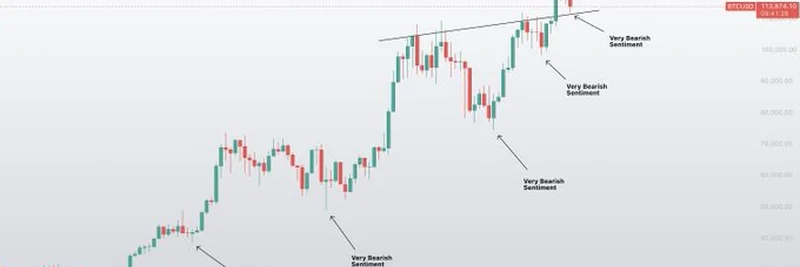Ever wondered why the crypto market seems to move in mysterious ways? A recent tweet from Sykodelic on X (@Sykodelic_) dives deep into this phenomenon, highlighting a key lesson that 99% of investors might overlook: mastering market sentiment. Let’s break it down and see how this can level up your crypto trading game, especially if you’re into meme tokens or other volatile assets.
What Is Market Sentiment, Anyway?
Market sentiment is basically the overall mood or attitude of investors toward a particular asset, like Bitcoin or a hot new meme coin. It’s not about the nitty-gritty financial details but rather the collective emotions—fear, greed, or uncertainty—that drive price movements. Sykodelic’s chart, which tracks Bitcoin’s price over time, marks moments of “very bearish sentiment”—times when everyone’s panicking and selling off.
Surprisingly, these bearish dips often lead to price reversals and upward trends. Why? Because emotional reactions tend to exaggerate market moves, creating opportunities for those who can think logically instead of following the crowd.
The Emotional Trap in Trading
Sykodelic points out a common pitfall: most investors let their emotions dictate their decisions. When prices drop and sentiment turns bearish, people rush to sell, fearing more losses. Conversely, when prices soar and everyone’s feeling bullish, they jump in—often right before a downturn. This emotional rollercoaster keeps them one step behind the market.
For example, the chart shows several instances where “very bearish sentiment” hit, only for the price to climb higher afterward. This suggests that the lowest points of fear can actually be the best times to buy, while peak optimism might signal a sell-off.
Turning Fear into Opportunity
So, how do you flip the script? The trick is to process fear paradoxically. When the market looks “shit” (as some X users put it), it might be nearing a support level—a price floor where buying interest picks up. On the flip side, when everyone’s hyped and prices hit resistance (a ceiling where selling pressure increases), it could be time to cash out.
Sykodelic’s advice? Don’t react to the fear. Instead, see it as a green light for opportunity. This mindset shift can transform how you trade, putting you in control rather than letting the market dictate your moves.
What’s Next for Crypto Traders?
The tweet ends with a thought-provoking question: “What do you think happens next?” Based on the pattern, if we’re seeing bearish sentiment again, history suggests a potential reversal and upward move. Of course, this isn’t a crystal ball—crypto’s wild nature means anything can happen. But understanding sentiment gives you an edge to plan your next move, whether you’re holding a meme token or a major coin like Bitcoin.
Tips for Meme Token Enthusiasts
If you’re into meme tokens (check out the latest trends on meme-insider.com), this lesson is extra relevant. These assets often ride waves of hype and panic. By watching for sentiment shifts—say, on X or in community chats—you can spot undervalued gems during a dip. Just remember to pair this with your own research and risk management!
Final Thoughts
Mastering market sentiment isn’t rocket science, but it does take practice to overcome emotional instincts. Sykodelic’s insight reminds us that the market’s mood swings can be your ally if you approach them with a clear head. So, next time you see a “very bearish” moment, take a deep breath, analyze the chart, and consider if it’s your cue to act. What’s your take—ready to level up your trading strategy?


